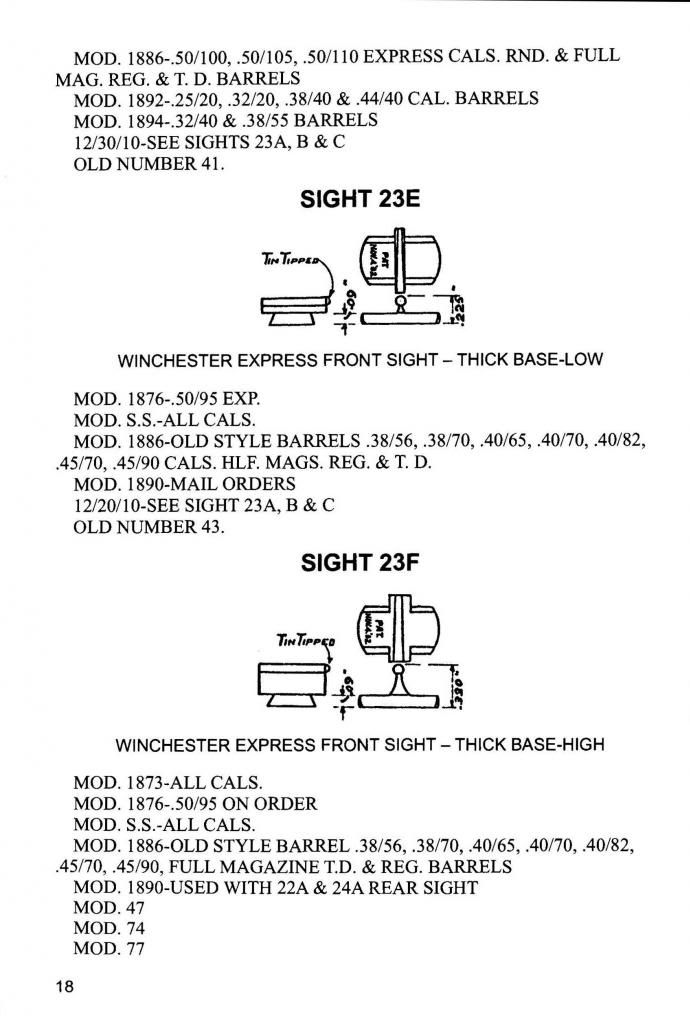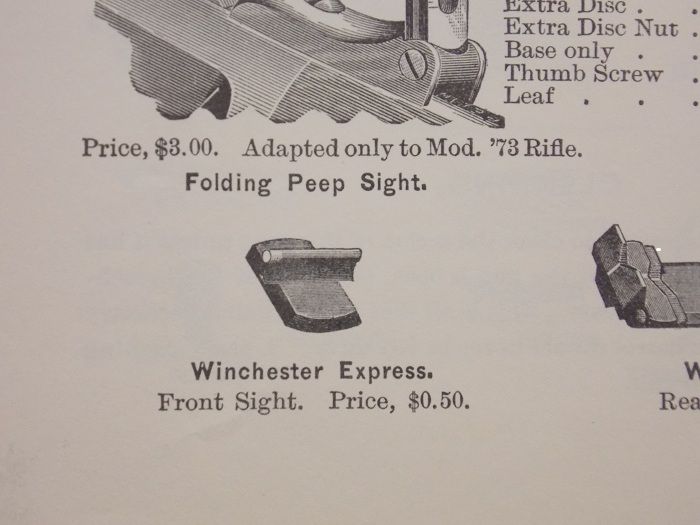I have a 1st model 1890 that letters with an "Express" front sight. All of the catalog pictures show this sight looking just like about a million other front sights.
Does anybody have a good picture of an actual, lettered Express front sight?
Better yet, anybody have one for sale?
MG:
From the Madis Sight Book:
http://s234.photobucket.com/user/RickInOregon/media/ExpressFrontSight.jpg.html
This may be better than a picture!
WACA Life Benefactor Member
NRA Life Member
Rick, is the patent date ’02?? This is on an 1891 rifle.
The drawings & catalogs all show a sight that looks like Lyman. I was hoping for an actual picture to try and pick out some particular shape or nuance that would easily identify the actual Winchester sight. Thoughts?
MG1890: From the 1891 catalog:
http://s1226.photobucket.com/user/hurint/media/DSCN4847_zps436f3472.jpg.html
As always, I would be happy for discussion or to be corrected here if I am in error. I don’t have any 1890s. Here is one on an 1894 from a later time, photo courtesy of Matt74:
http://s1226.photobucket.com/user/hurint/media/IMG_2200_zpsb83e797a.jpg.html
[Image Can Not Be Found]
The sight on the 1894 is from well after 1902, is tin tipped and bears the patent date stamp. I’ve posted this before, but here it is again:
http://www.google.com/patents/US712863?pg=PA2&dq=A.+Tilton+Winchester+front+sight&hl=en&sa=X&ei=ha5sUaeVCsi4yAGBm4GYBA&ved=0CDQQ6AEwAA#v=onepage&q&f=false
Then the bluing is removed by buff ing, filing, or otherwise from the rear end of the sight-rib 3. The exposed metal is then treated with acid to clean the metal, so as to secure a surface to which another metal will cohere. The sight is then dipped into the bath of the sight-point metal, whatever it may be, so as to expose its cleaned and acidtreated surface thereto. When now the sight is lifted from the bath, a small globule-like mass of the sight-point metal will be found adhered to the sight. This little mass of metal hardens before it can drop back into the bath and forms a symmetrical globulelike sight-point which coheres directly to the metal of the sight proper in such a way that it virtually becomes an integral part thereof. If desired, it can afterward be trimmed, shaped, and finished. It takes the place of the ivory sight-points which heretofore have very generally been employed and which are not only expensive, but frail.
It’s my belief then the patent date mainly refers to the "tin tipping", or whatever you want to call it, of a front bead in the attempt to make it more durable than other materials. Since the 1890 in question is a few years prior to this 1902 date, I’d suggest finding a sight that looks like either one in the picture but without a tin tipped bead or patent date stamp. I would guess ivory or maybe a "gold" bead might be the one? (edit: maybe all steel too?)
I’m not sure that Lyman made a front sight with a base similar to the Winchester Express Front Sight. Some of the early Lyman sights may have their patent dates marked on them but no other Lyman marking. This one here in these pictures might be one of those, it sold awhile ago on ebay. Otherwise the Lyman sights may have letter application codes under them too, have a "Lyman" or "LYMAN" stamp or both. Obviously this one pictured is different in appearance to a Winchester Express front sight:
http://s1226.photobucket.com/user/hurint/media/T2eC16hHJGwE9nyVUTiBRKuypIIR60_12_zps82f4b98a.jpg.html
[Image Can Not Be Found]
http://s1226.photobucket.com/user/hurint/media/T2eC16hHJGQE9noMcScOBRKuyohVw60_12_zps17085de8.jpg.html
[Image Can Not Be Found]
I hope you are able to identify the Winchester sight based on these pics. I’ll look for more pics too.
Brad
MG1890 said
Rick, is the patent date ’02?? This is on an 1891 rifle.The drawings & catalogs all show a sight that looks like Lyman. I was hoping for an actual picture to try and pick out some particular shape or nuance that would easily identify the actual Winchester sight. Thoughts?
I guess I should have mentioned the main nuance in the Winchester sight is the length of the blade is slightly over the width of the base of the sight at both the front and rear.
Brad
1 Guest(s)


 Log In
Log In Members
Members Home
Home

 Add Reply
Add Reply Add Topic
Add Topic


 Offline
Offline




